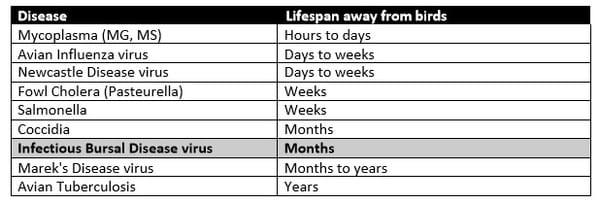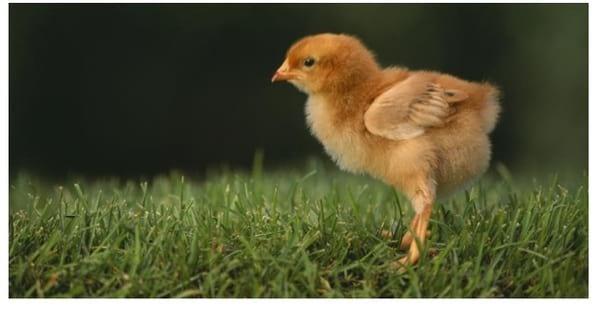Infectious bursal disease (also known as IBD, Gumboro Disease, Infectious Bursitis and Infectious Avian Nephrosis) is a highly contagious disease of young chickens caused by infectious bursal disease virus (IBDV), characterized by immunosuppression and mortality generally at 3 to 6 weeks of age. The disease was first discovered in the USA, near the town of Gumboro, Delaware in 1962. It is economically important to the poultry industry worldwide due to increased susceptibility to other diseases and negative interference with effective vaccination. In recent years, very virulent strains of IBDV (vvIBDV), causing severe mortality in chicken, have emerged in Europe, Latin America, South-East Asia, Africa and the Middle East. Infection is via the oro-fecal route, with affected bird excreting high levels of the virus for approximately 2 weeks after infection.
IBD is caused by a highly contagious Birnavirus. The virus is often associated with great economic losses in the poultry enterprises. This pathogen is resistant to many disinfectants and environmental factors, and remains infectious for at least four months in the poultry house environment. Because of the resistant nature of the IBD virus, once a poultry house becomes contaminated, the disease tends to recur in subsequent flocks.
Table 1: Longevity of Selected Poultry Disease-Causing Organisms in the Environment
Transmission of IBD Virus
Chickens infected with the IBD virus shed the virus in their feces. Feed, water, and poultry house litter become contaminated. Other chickens in the house become infected by ingesting the virus. The mode of transmission is primarily through the fecal-oral route. The lesser mealworm (Alphitobus diaperinus) has been shown to carry the virus. Because of the resistant nature of the IBD virus, it is easily transmitted mechanically among the farms by people, equipment and vehicles.
Subclinical and Clinical IBD
Clinical disease is associated to bird age with the greatest bursal mass, which occurs between 3 and 6 weeks of age. The greatest bursal mass is mostly a result of a large population of maturing IgM-bearing B-lymphocytes (lymphoblasts), the main target of infection. Young birds at around 2 to 8 weeks of age that have highly active bursa of Fabricius are more susceptible to disease. Birds over eight weeks are resistant to challenge and will not show clinical signs unless infected by highly virulent strains.
Subclinical disease occurs in chickens infected before three weeks of age. At this age the Blymphoblast population is smaller and the systemic effects are insufficient for generating clinical signs. However, the B-cell destruction is usually most severe in sub clinically infected young chickens, as virus will destroy a smaller population and most cells in one place (the bursa). Subclinical disease increases susceptibility to other infections, such as E. coli, Salmonella, Mycoplasma, Coccidia, Marek’s disease and others.
The majority of field infections are subclinical, and this form is the most economically important form of the disease. Broilers grown on these farms typically have poor body weights and feed conversions, high mortality, excessive reactions to respiratory vaccines, and high rates of condemnation at processing. In many cases, investigations have shown that these farms are heavily contaminated with the IBD virus. The poor performance of the broilers is due to factors relating to immunosuppression caused by subclinical IBD.
Acute disease and death is due to the necrotizing effect of these viruses on the host tissues. Kidney failure is a common cause of mortality. If the bird survives and recovers from this phase of the disease, it remains immunocompromised which means it is more susceptible to other diseases.
Disease may appear suddenly and morbidity typically reaches 100% in the acute form. Mortality can range from 5% – 20%. The severity of the disease will depend on the age and breed of chicken and the virulence of the virus. From 1987 in Europe and later on in Asia and other parts of the world, the new hyper virulent strains emerged and were characterised by a very high mortality of up to 80% in layer pullets and 25% in broilers. Thus clinical acute IBD became predominant with additional losses due to specific mortality.
A typical example of the mortality rate and economic consequences associated with outbreaks of very virulent strains of IBDV (vvIBDV) are the numbers below:
Table 2. Key-numbers for vvIBDV outbreak in Denmark – year of 1998
Table 3. Economic consequences of wIBDV outbreak in Denmark 1998
*Conversion from DKK to EURO has been made using the 1999 exchange rate
One major consequence of immunosuppression is decreased feed efficiency. Poor feed utilization destroys the flock uniformity. It is well known that in highly advanced poultry operation systems with a lot of automation, especially at the processing plant, the impact of carcase uniformity on the economic result of the industry may be huge. Other detrimental effect of poor control of immunosuppression is indirectly recorded by the increased cost of medication, and especially by the increased cost of antibiotics for secondary bacterial infection treatment and prevention.
The total cost of IBDV infections is difficult to calculate since it depends on multiple factors such as the breed and the age of the chicken, the strain of virus, previous protection from vaccination, natural infection or maternal antibodies, the level of immunosuppression caused and secondary infections. The costs not only include the losses of dead and diseased animals, but also the costs of extra labour, veterinarians, medications and disinfection strategies. There is no doubt, however, that the disease causes serious economical losses. For example it is estimated that the money saved after having introduced vaccination in 1988-89 in the USA was 400 million US dollars in 1990 and 580 million in 1998 (De Wit, 2001). In the United Kingdom the cost of Gumboro in 1994 was estimated to be 15 million GBP.
Additional information how costly the disease might be is provided by few simulations performed within a different time interval. One of them estimated a loss of US $10 million per year in the event of introduction of classical strains IBDV into New Zealand. In the second, Shane et al, simulating two broiler operations in North America under the same conditions, one infected by IBDV, the other uninfected. The results estimated that the introduction of IBD would cause a 10% rise in production costs.
Prevention and Control of IBD
What elements need to be taken into consideration in order to achieve a comprehensive prevention strategy?
The IBD virus is extremely resistant to physical and chemical agents. That means, once a farm becomes contaminated, the virus persists in the environment for a long period of time, risking infection and economic losses to successive flocks. An effective IBD prevention and control program must involve an effective breeder vaccination program, an effective biosecurity program, and an effective broiler vaccination program. Relying on broiler vaccination has met with only limited success when not coordinated with effective breeder vaccination and biosecurity programs. Immunization of breeders is an important part of the IBD control program. Antibodies produced by the hen are passed through the egg to the broiler chick. These maternal antibodies, if present in adequate levels, protect the chicks against subclinical IBD.
Effective control of IBD in commercial broilers requires that field virus exposure be reduced by proper clean-up and disinfection between flocks, and the traffic (people, equipment and vehicles) onto the farm be controlled. The development and enforcement of a comprehensive biosecurity program is the most important factor in limiting losses due to IBD. The sanitary precautions must include “all in all out” farming methods. In between flocks thorough cleaning and disinfection of the poultry house and equipment must take place. This involves the removal of all organic matter and dust, washing the buildings with a high pressure with hot water and detergent, followed by the application of disinfectants. Efforts at biosecurity (cleaning, disinfecting, traffic control) must be continually practices, as improvement is gradual and often only seen after 3 or 4 flocks.
The stability of IBD virus in the environment, the economics of poultry production requiring very often short fallow periods between chicken batches and possible litter re-use encourage persistence IBDv outbreaks that requires absolute dependence on vaccination using live and killed IBD vaccines to keep Gumboro in check because control through sanitation may not be practicable in most poultry farms.
However Biosecurity should certainly be the corner- stone of any long-term response to disease aggression. Poultry producers worldwide should now seriously consider taking steps to institute effective biosecurity programmes to exclude disease carrying vectors from entering the farm environment.
While the cost of endemic disease is significant the cost of subclinical disease must not be ignored. Challenged by disease that is not apparent, birds will show reduced performance and productivity. This will be seen in increased mortality and culling, reduced weight gain and increased downgrading at processing. In the Mcllroy study, an 11% improvement in income per 1,000 birds was seen in farms with unaffected flocks over farms with evidence of acute Gumboro infection. Moreover, a 14% improvement in income per 1,000 birds was seen in unaffected flocks compared to farms with evidence of chronic Gumboro infection.
It is a fact of life that in modern intensively reared poultry production, disease causing pathogens are easily transmitted and can cause mortality and reduced productivity within a flock. Disease prevention is always less expensive than treatment and the cost of implementing appropriate biosecurity systems is small when compared to the financial profit that can be made from increased production. The use of effective disinfectants is vital in biosecurity to ensure that disease carrying vectors are eliminated before they infect valuable stock.
One key element every biosecurity protocol needs to contain is the correctly selected hygiene and disinfection agent. Having a solid grasp on that matter company Vitfoss offers Stalosan F -
Unique powder disinfectant that provides sustained suppression of pathogens in poultry production and poultry housing facilities
Stalosan F – effectiveness of the product vs. IBDv
Recently conducted study at the University of Minnesota exhibits the potential of Stalosan F to supress IBDv.
This experiment was done in duplicate. The Study Conclusion indicates that: Stalosan F powder, when applied at 10mg/2cm2 and 20mg/2cm2 surface area, was able to inactivate ≥99.97% and ≥99.99% of IBDV within 1 h respectively.
The Statistics provide additional figures to the explanation : Conducting test between the mean value of control and Stalosan F at different time points revealed significant decline in the virus titer due to Stalosan F 10mg and 20mg application (P<0.01) .
Stalosan F is a fine pink powder. The existing composition of Stalosan F is based on synergism, where two or more ingredients reinforce each others effect. This product possess a wide spread antimicrobial mode of action and prevents the proliferation of pathogenic micro-organisms.
Apart from control over the most frequently observed pathogenic micro-organisms, Stalosan F has been proven to have a significant reduction of ammonia formation, absorb excessive moisture, decrease the pH-value of the litter, contribute to significantly better air quality through minimising the harmful emissions in the air and improve the overall performance of the flock.
When applied weekly the product can improve the biosecurity status of the animals and minimise the disease spreading incidence. At the same time the product is completely harmless for the humans and the animals which makes the material a very good option to be applied at the same time when birds are present in the barns.
Preventive application
Add 50 gr. of Stalosan F to every 1 sq. meter. If the area is badly affected, increase the dosage slightly. Initially apply Stalosan F once a day for 3 days in a row. Continue treatment once a week, thereafter.
Specific application
In case of increased pathogen pressure, the frequency of applications should be elevated to 2-3 applications per week at 50 - 100 gr. of Stalosan F to every 1 sq. meter.
















.jpg&w=3840&q=75)